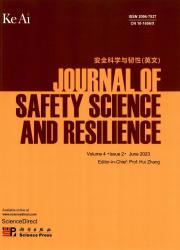Selecting vehicle dispatching plan for typhoon emergency evacuation based on fault-tolerance analysis
IF 3.4
Q1 PUBLIC, ENVIRONMENTAL & OCCUPATIONAL HEALTH
引用次数: 0
Abstract
Unexpected scenarios often occur during typhoon response, which is likely to cause the failure of evacuation vehicle dispatching and other preparedness plans. To solve this problem, a vehicle dispatching plan selecting method based on fault-tolerance analysis is proposed, which considers the bounded rationality of emergency decision-makers. The method improves the capability of responding to unexpected scenarios by increasing backup resources. First, under the expected scenarios, a bi-level programming model for arranging the quantities of each type of vehicle and their routes is established, with the goal of minimizing the expected total evacuation time. A corresponding solving algorithm is designed. Second, possible unexpected scenarios are preset by integrating local and non-local historical experiences, and the scenario influences on vehicle dispatching constraints are analyzed. Third, under unexpected scenarios, a fault-tolerance plan set is established considering the failure risk of vehicle dispatching and fault-tolerant cost. The optimal plan is selected by calculating and ranking fault-tolerant rates. Finally, a case study in Shenzhen, China is provided to verify the reasonability and effectiveness of the method. The results show that the proposed method can help discover and address the ‘fault’ of vehicle dispatching plans during emergency preparedness and thus improve evacuation capabilities in emergency response. The proposed method can be used to develop evacuation vehicle dispatching planning methods with comprehensive scenario adaptability and a precisely improved capability.
基于容错分析的台风应急疏散车辆调度方案选择
在台风应对过程中,经常会出现意想不到的情况,这很可能导致疏散车辆调度和其他准备计划的失败。针对这一问题,提出了一种考虑应急决策者有限理性的基于容错分析的车辆调度方案选择方法。该方法通过增加备份资源,提高了对突发场景的响应能力。首先,在预期场景下,以期望总疏散时间最小为目标,建立了规划各类车辆数量和路径的双层规划模型。设计了相应的求解算法。其次,结合本地和非本地历史经验,预设可能出现的意外场景,分析场景对车辆调度约束的影响;第三,在突发情况下,考虑车辆调度的故障风险和容错成本,建立容错计划集。通过对容错率的计算和排序,选择最优方案。最后,以中国深圳市为例,验证了该方法的合理性和有效性。结果表明,该方法有助于发现和解决应急准备过程中车辆调度计划的“故障”,从而提高应急响应中的疏散能力。该方法可用于开发具有综合场景适应性和精确改进能力的疏散车辆调度规划方法。
本文章由计算机程序翻译,如有差异,请以英文原文为准。
求助全文
约1分钟内获得全文
求助全文
来源期刊

安全科学与韧性(英文)
Management Science and Operations Research, Safety, Risk, Reliability and Quality, Safety Research
CiteScore
8.70
自引率
0.00%
发文量
0
审稿时长
72 days
 求助内容:
求助内容: 应助结果提醒方式:
应助结果提醒方式:


